This post may contain affiliate links. Please read my disclosure policy.
The ultimate guide to preparing, cooking, and storing healthy freezer meals… plus, some of our favorite freezer-friendly recipes!
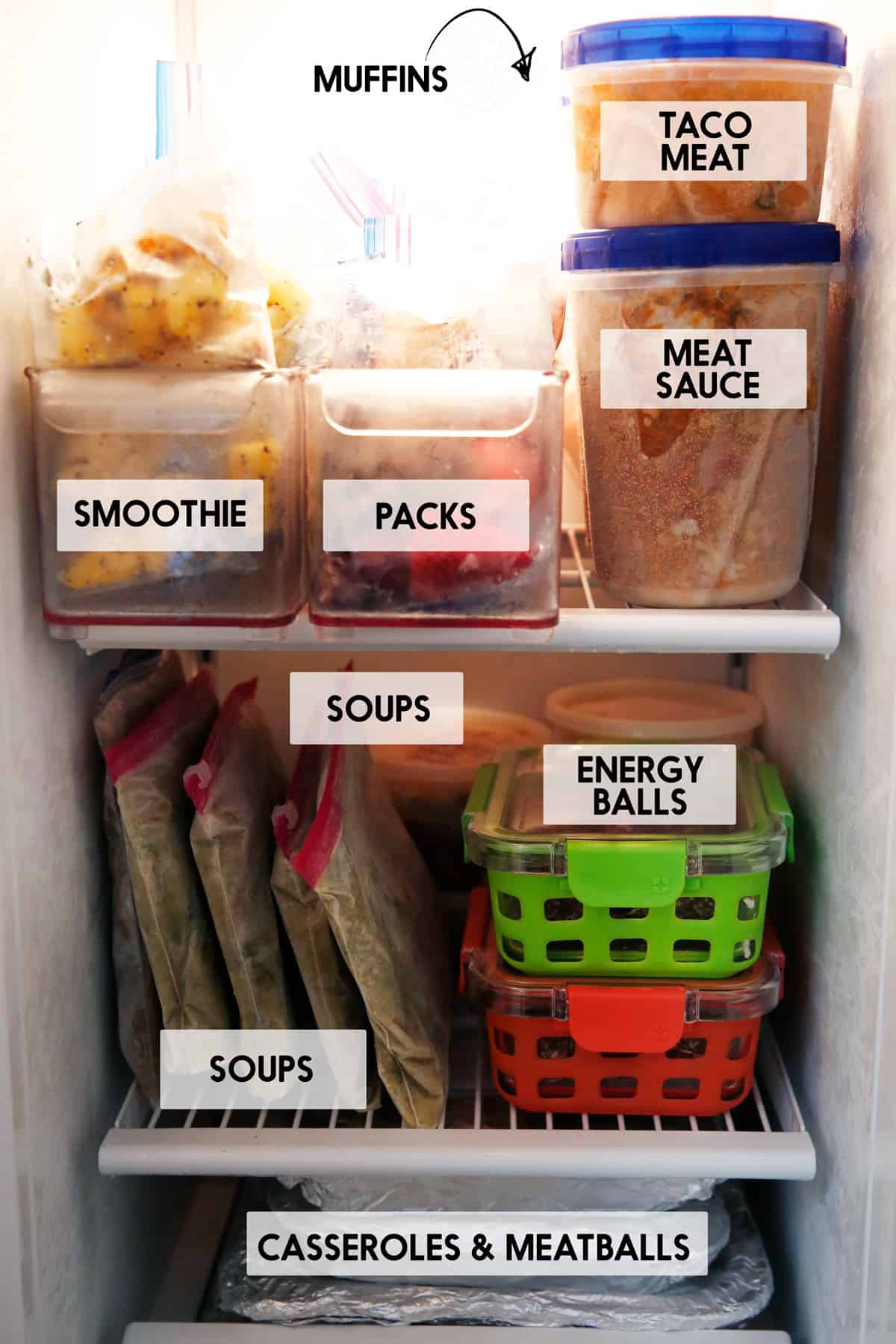 Ultimate Freezer Meal Guide
Ultimate Freezer Meal Guide
As far as we’re concerned, the freezer is one of the most underutilized cooking tools out there — especially for busy families. Freezing foods and meals not only combats food waste, but it also makes getting a healthy home-cooked meal on the table so much easier.
But here’s the thing… figuring out what foods actually freeze well and taking the right steps to make that happen can be tricky. We’ve all been victims of freezer burn!
This freezer cooking guide will walk you through exactly what foods and meals freeze well, how to freeze food, and how to defrost and reheat frozen food. Stay tuned until the end, where we’ll also share some of our favorite meals and recipes from the archives.
What makes a freezer meal?
A freezer meal is any recipe made with the intention of going into the freezer to be served at a later date. It can be a recipe where ingredients are simply gathered and frozen (like this “Dump” Southwest Chicken Soup) or it can be cooked in its entirety and frozen for consumption at a later date (like these Breakfast Burritos).
You can also make prepared ingredients (like cooked lentils) in advance and freeze them in bulk. Sauces — including tomato sauce or vegan cheese sauce — or baked goods (such as almond butter cookies) can also be frozen. The freezer really gives you so many possibilities!
Best Foods to Freeze
Nearly anything can be frozen, but some foods freeze better than others. Here are some of our favorite things to freeze:
- Casseroles
- Soups and stews
- Muffins and breads
- Smoothie packs
- Marinated meat
- “Freezer Dump” meals
- Breakfast or dinner burritos
- Baked egg cups or frittatas
- Meatballs
- Breaded chicken
- Braised or slow cooked meats
Foods That Don’t Freeze Well
And then there are the foods that don’t take to the freezer so well! While there are exceptions to every rule, we’ve found that these items are not-so-freezer-friendly…
- Fried foods
- Anything with mayo
- Foods with cream (these tend to separate when frozen, so if you do choose to freeze them, they might not defrost the way you expect)
- Fresh veggies with high water content (such as raw tomatoes or fresh lettuce, which will wilt when defrosted)
- Raw potatoes (these tend to turn brown in the freezer)
 Freezer Cooking Food Safety
Freezer Cooking Food Safety
Safety is always first, so let’s dive into some key rules to follow when it comes to freezer cooking and storage.
The Danger Zone
Keeping food at the correct temperature is very important, since it slows the growth of bacteria. The danger zone for bacteria growth for food is the range of temperatures between 40°F and 140°F, which can allow bacteria growth to double in as little as 20 minutes, according to the USDA. Keep this in mind when handling food for the freezer!
Freezing food doesn’t kill bacteria, but simply stalls its growth. Be sure not to allow too much bacteria growth before you put food in the freezer. The freezer puts the bacteria to sleep, but once food is thawed, bacteria reactivates and will continue to grow.
Correct Freezer Temperature
Nothing is more important than making sure your freezer is at the correct temperature: at or below 0ºF. And you can’t always trust the internal thermometer of a freezer! Invest in an inexpensive separate freezer thermometer to ensure your food is consistently at or below 0ºF. If your freezer is constantly fluctuating in temperature above that, food will deteriorate more quickly.
Properly Cooling Food Before Freezing Food
Never stick hot — or even warm! — food in a freezer. Putting food in a freezer when it’s at a high temperature can increase the overall temperature in the unit and may place all of the food in the danger zone.
Instead, cool very hot at room temperature before moving it to the refrigerator, uncovered for finish cooling. Place it in the freezer once it’s at least room temperature or chilled.
How to Safely Defrost Food
Hands down, the best way to defrost food is in the refrigerator, overnight. This is ideal in terms of food safety, but it’s also your best bet in preserving the taste and integrity of the food.
How Long to Store Freezer Meals
Generally speaking, you can safely store frozen food for about 12 months, but the longer you store it, the more likely you are to experience a change in taste. You also increase the chance of freezer burn over time. We recommend storing freezer meals for no longer than three months, but ideally using them within one or two months.
Wash Your Hands!
This may seem like a no brainer, but when you are preparing food for storage, it never hurts to get a friendly reminder about basic food safety practices! Wash your hands thoroughly for at least 30 seconds with warm soap and water before handling any food, and especially after handling raw meat.
Food Integrity
You may be tempted to toss leftovers that have been hanging around for a few days in the freezer in an effort to save them, but… don’t. We strongly recommend against it! It’s best to only freeze food that is already of the best quality and freshness. While putting food in the freezer slows down deterioration, it doesn’t magically improve the quality. If you put nearly-expired food in the freezer, that food will still be nearly expired when you take it out. It may even be in worse shape than that!
A Full Freezer Works Better than an Empty One
A full freezer regulates its temperature more effectively than an empty one, but you don’t want to have it so stuffed that you block airflow throughout. If you notice you have freezer burn on the outside of containers, you probably have a problem with airflow.

How to Store Freezer Meals
Before you finalize that meal plan, you may want to keep in mind some of the important moving parts specific to freezer meals.
Making Space for Freezer Meals
The first thing to think about when planning for freezer meals is, of course, how much space you actually have in your freezer! If you are working with just one freezer, go ahead and clean it out to the best of your ability and assess how many meals you can fit in there.
Portion Sizes
The next thing to consider is portion sizes. Who are the meals for? If the meals are for your whole family, it likely makes sense to freeze food in large enough portions to feed everyone. If you are making meals for a family of one or two, plan to freeze smaller portions. Containers are key…
Storage Containers
Most of the time, we love using glass storage containers and silicone storage bags, but those aren’t always the best choice for planning freezer meals. Meals can be frozen for a few weeks or months, so it makes more sense to use containers you don’t mind losing for a longer period of time. Plus, eco-friendly glass and silicone containers are often bulkier and may take up an unreasonable amount of space in your freezer.
For freezer meals, specifically, we lean toward other storage options.
Disposable aluminum baking pans are great to use for anything that needs to be baked after being defrosted, such as Baked Zitis, Lasagnas, or Enchiladas. If you want to avoid buying or using these disposable dishes, you can line a glass baking dish with greased foil and then assemble the casserole there. Freeze the casserole until frozen solid, then remove the casserole from the baking dish. Wrap it tightly in plastic wrap and some additional foil. When you are ready to bake it, place it back in the original casserole dish without the foil and plastic wrap. Defrost as instructed.
You can also look for plastic bags that are marketed specifically for freezer storage, which are made of thicker plastic and are less likely to break. These are great for storing everything from baked goods to soups. When storing soup, stews, or chili, fill the plastic bags and flatten them out and stack them on top of one another and freeze. Once fully frozen, you can store them horizontally, if needed, in the freezer. See the first photo in this post to see this in action.
How to Prevent Freezer Burn
The primary cause of freezer burn directly on food is extra air, so it’s best to always be thinking about ways to eliminate as much air from containers as possible. This prevents the build-up of water crystals — AKA freezer burn — on food.
Here’s a tip: If there is a gap between the food you’re freezing (like a casserole) and the top of the container, place a piece of wax or parchment paper over the food to try to prevent freezer burn. If you’re wrapping containers with plastic wrap, wrap twice and cover with aluminum foil.
Labeling Your Food
Make sure to label all the food that goes in the freezer. You might think you’ll remember what everything is, but take it from us — it’s easy to forget or lose track! When labeling, include the name of the food, as well as the date it was made or the use-by date (generally three months after it was prepped, but this can vary). Include heating instructions to make life even easier for future you!
Keeping a freezer inventory on a piece of paper outside of your freezer is super helpful for keeping track of everything you have inside. We’ve created a free inventory that will give you a clear picture of what food is in your freezer. This will make meal planning for your family much easier.
First In, First Out
If you are continually adding new freezer meals to your stash, make sure to constantly rotate the items in your freezer. More recently added food should go to the back or bottom of your freezer to ensure you are using the older food first. You’ll be less likely to lose food this way!
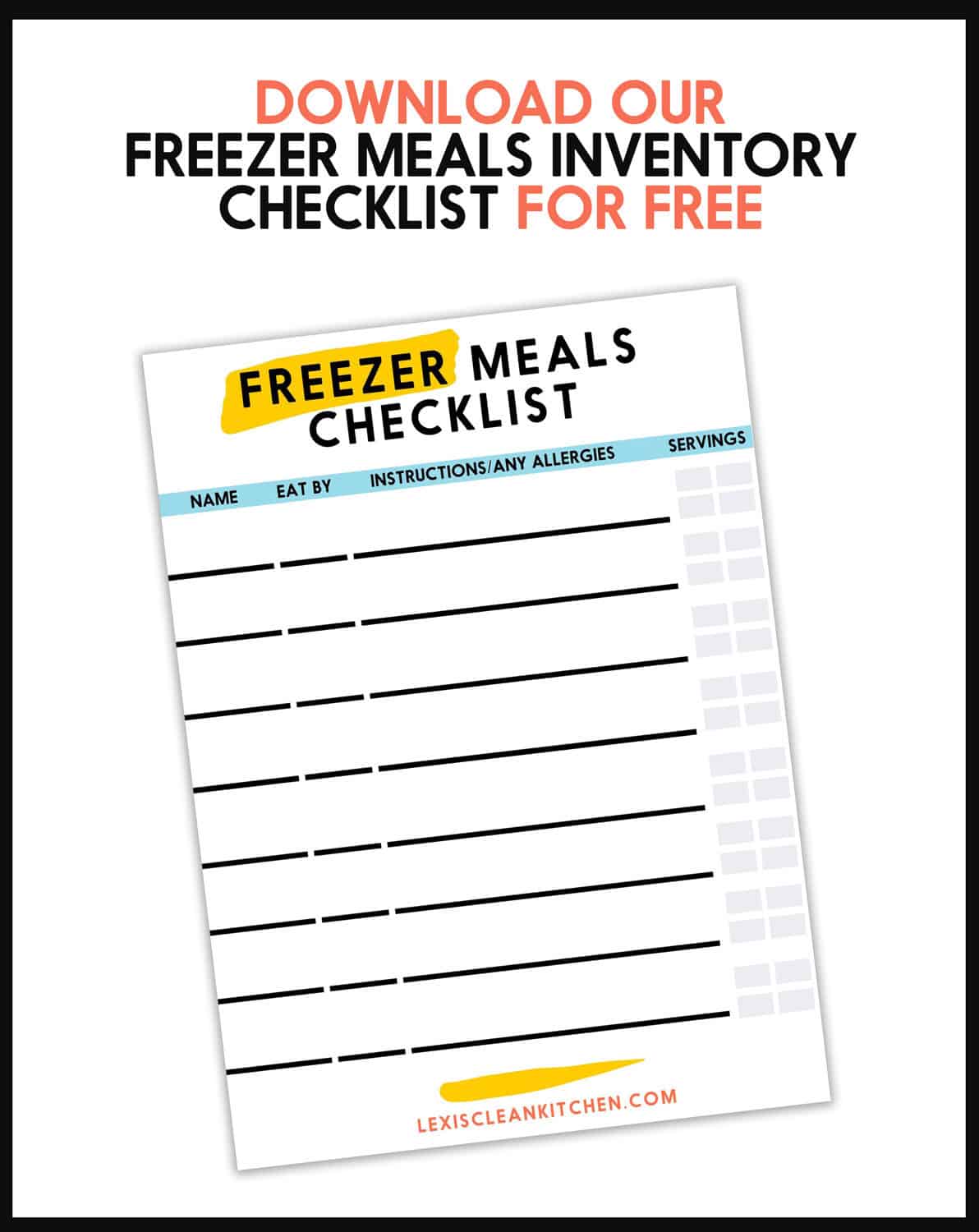
How to Reheat Freezer Meals
So you’ve done all this work to pack your freezer full of lovingly-made, healthy meals and snacks. Now what? Reheating and/or finishing is half the battle when it comes to freezer cooking!
What’s the best way to reheat freezer meals? The first piece of advice we can offer is to check the directions of the recipe. If a recipe is marked as freezer-friendly, it often will include instructions for freezing and reheating. If it doesn’t, we’re offering some basic advice on how to reheat meals.
Minimum Temperature of Reheated Food
There is one universal piece of advice when it comes to reheating food: All frozen food should come up to a temperature of at least 165ºF. We recommend using a clean meat thermometer directly in the center of the food to ensure your food has reached a proper temperature. We live by our ThermoWorks MK4.
It should take no more than two hours to reach that temperature. If it takes longer than that, the food has been sitting at an unsafe temperature for too long and shouldn’t be eaten, anyway.
Defrosting Freezer Meals
The most important step when it comes to reheating! If at all possible, it is always the best choice to slowly defrost freezer meals in the refrigerator overnight or for up to two days.
Defrosting Soups / Chilis / Braises
If you don’t have time to fully defrost soups or other foods that you can reheat on the stove top, you can place the container in a bowl of warm water until the food can easily pop out of the container. Once you are able to get it out, place the freezer meal contents in a pot with about 1/4 to 1/2 cup water. Cover the pot and cook over medium to medium-low while stirring semi-frequently. Once the entire meal has defrosted, bring the contents up to a boil to make sure it’s fully reheated.
Defrosting Baked Goods
Baked goods without a lot of moisture (such as muffins and breads) can be defrosted at room temperature on the counter. Muffins defrost quickly — usually in about 30 minutes or so — so you can take them out of the freezer in the morning of the day you plan to eat them.
Raw cookie dough doesn’t always need to be defrosted before being baked. The cookies will likely just need to be baked for longer than the recipe instructs to fully cook through. Fully baked cookies can be defrosted similar to muffins.
Defrosting and Heating Frozen Burritos
No need to defrost these! Unwrap the burritos and place on a plate with the seam side down. Reheat in a microwave for 2-4 minutes until heated through, or place in a toaster oven and bake for 15 minutes, or until heated through.
Baking Freezer Meals
The best way to reheat a freezer meal that is originally intended to be baked in the oven (such as a casserole or enchiladas) is, of course, to reheat the food in the oven. Makes sense, right?
Once the food is defrosted, loosely cover it with foil and bake according to the recipe’s reheating instructions, or at 350ºF until the center of the food reaches at least 165ºF. Don’t forget: It should take no more than two hours to reach 165ºF.
Microwave
Ideally, food should be fully defrosted before it’s reheated in a microwave. Keep in mind that food reheated in the microwave will not have any crispy edges and can tend to reheat unevenly. Some foods are great reheated in the microwave, such as burritos, whereas other food such as chicken tenders, are not. Stirring food such as soups throughout cooking ensures even cooking. Make sure the food reaches an internal temperature of 165ºF.

Freezer Meal FAQ
Q: What food can be frozen?
A: The truth is, nearly everything can be frozen. But that doesn’t mean that you are going to be happy with the quality of the food once it is thawed. Scroll up to the sections labeled “best foods to freeze” for more specifics.
Q: How long can you store freezer meals?
Generally speaking, you can safely store frozen food for about 12 months, but the longer you store it, the more likely you are to experience a change in taste or texture. You also increase the chance of freezer burn over time. We recommend storing freezer meals for no longer than three months, but ideally using them within one or two months, though there is some variation in this advice depending on the food.
Q: Can you refreeze previously frozen food?
A: According to the USDA, it is safe to refreeze frozen food that has not been cooked. However, you may find that the quality has deteriorated slightly because of the loss of moisture during the initial defrost. We have found it not worth it to refreeze a baked freezer meal, such as Lasagna. The loss of quality is too noticeable.
Q: Can you microwave frozen food?
A: Yes, though to be clear, it is not our first choice. Microwaving food has a tendency to make it soggy and soft, which often isn’t a desirable quality in most meals. We prefer to use the stove top, oven or toaster oven.
Q: Does food lose nutritional value when frozen?
A: No! If frozen at the peak of ripeness, frozen food retains nearly all of its nutritional value.
Q: Is it safe to eat food with freezer-burn on it?
A: Yes. Freezer burn is simply some dried out spots where the food has come into contact with air. If possible, cut off any portion of the food with freezer burn, for quality purposes. If food is very badly covered in freezer burn, it may not taste as good, and should be discarded. Truly, this is a personal choice, though it is not unsafe to eat food with freezer burn.
 60 Healthy Freezer Meals and Ideas
60 Healthy Freezer Meals and Ideas
Now that you know all the nitty-gritty when it comes to preparing freezer meals, it’s time to pick out the recipes!
We’re sharing over 60 of our favorite freezer-friendly meals, as well as some of our favorite food to store in the freezer.
Freezer-Friendly Breakfast Recipes
Breakfast Burritos: Freeze for 3 months. To reheat, unwrap them and place on a plate with the seam side down. Reheat in a microwave for 2-4 minutes until heated through, or place in a toaster oven and bake for 15 minutes, or until heated through.
Overnight Oats: Fridge for up to 5 days.
Potato, Leek, and Chard Frittata: Use within 2-3 months. Defrost overnight in the refrigerator and reheat in a 350ºF until warmed through, 20-30 minutes, and reaches a temperature ab0ve 165º.
Gluten Free Banana Bread: Freeze for up to 3 months, defrost at room temperature.
Maple Blueberry Baked Oatmeal: Freeze for up to 3 months, defrost at room temperature, or microwave for a few minutes to warm up.
Peanut Butter, Banana, Chocolate Baked Oatmeal: Freeze for up to 3 months, defrost at room temperature, or microwave for a few minutes to warm up.
PB&J Baked Oatmeal: Freeze for up to 3 months, defrost at room temperature, or microwave for a few minutes to warm up.
Raspberry Oat Breakfast Bars: Freeze for up to 3 months, defrost at room temperature.
Gluten Free Apple Muffins: Freeze for up to 3 months, defrost at room temperature.
Grain-Free Chocolate Chip Banana Muffins: Freeze for up to 3 months, defrost at room temperature.
Paleo Lemon Blueberry Muffins: Freeze for up to 3 months, defrost at room temperature.
Turkey Tex Mex Egg Muffin Cups: Use within 2-3 months. Defrost overnight in the refrigerator and reheat in a 350ºF until warmed through, 20-30 minutes, and reaches a temperature ab0ve 165º, or in the microwave.
Spring Vegetable Quiche: Use within 2-3 months. Defrost overnight in the refrigerator and reheat in a 350ºF until warmed through, 20-30 minutes, and reaches a temperature ab0ve 165º.
Pumpkin Waffles Freeze for 3-4 months, toast from frozen until warmed through.
Waffle Bites: Freeze for 3-4 months, toast from frozen until warmed through.
Fluffy Paleo Pancakes Freeze for 3-4 months, toast from frozen until warmed through.
Breakfast Burritos: Freeze for 3 months. To reheat, unwrap them and place on a plate with the seam side down. Reheat in a microwave for 2-4 minutes until heated through, or place in a toaster oven and bake for 15 minutes, or until heated through.
Freezer Smoothie Packs: Freeze for 1-2 months. When ready to use, blend from frozen.
Breakfast Cookies: Freeze for up to 3 months, defrost at room temperature.
Freezer-Friendly Main Dishes
Classic Chicken Soup: Freeze for 3-6 month. Defrost overnight if you are able. If you want to heat from frozen, you can place the container in a bowl of warm water until the food can easily pop out of the container. Once you are able to get it out, place the freezer meal contents in a pot with about 1/2 cup water. Cover the pot and cook over medium to medium-low while stirring semi-frequently. Once the entire meal has defrosted, bring the contents up to a boil to make sure it’s fully reheated.
Salmon Burgers: Leftover salmon patties will last for up to 2 days in the fridge or wrapped in freezer-safe wrapping in the freezer for up to 3 months. Defrost overnight in the refrigerator and reheat on stovetop, grill, or air fryer.
No-Bean Falafel: Freeze for 3 months. Freeze in a single layer on a baking sheet and then transfer to an airtight container or ziplock bag. Defrost overnight in the refrigerator and place in a baking container covered with foil, and reheat at 350ºF until warmed through, 20-30 minutes, and it reaches a temperature ab0ve 165º.
Nanny’s Sweet and Sour Meatballs: Use within 2-3 months. Freeze fully cooked meatballs. Defrost overnight in the refrigerator and place in a baking container covered with foil, and reheat at 350ºF until warmed through, 20-30 minutes, and it reaches a temperature ab0ve 165º.
Thai Meatballs: Use within 2-3 months. Freeze fully cooked meatballs. Defrost overnight in the refrigerator and place in a baking container covered with foil, and reheat at 350ºF until warmed through, 20-30 minutes, and it reaches a temperature ab0ve 165º.
Turkey Chili: Freeze for 3-6 month. Defrost overnight if you are able. If you want to heat from frozen, you can place the container in a bowl of warm water until the food can easily pop out of the container. Once you are able to get it out, place the freezer meal contents in a pot with about 1/2 cup water. Cover the pot and cook over medium to medium-low while stirring semi-frequently. Once the entire meal has defrosted, bring the contents up to a boil to make sure it’s fully reheated.
White Chicken Chili: Freeze for 3-6 month. Defrost overnight if you are able. If you want to heat from frozen, you can place the container in a bowl of warm water until the food can easily pop out of the container. Once you are able to get it out, place the freezer meal contents in a pot with about 1/2 cup water. Cover the pot and cook over medium to medium-low while stirring semi-frequently. Once the entire meal has defrosted, bring the contents up to a boil to make sure it’s fully reheated.
Sweet Potato Chili: Freeze for 3-6 month. Defrost overnight if you are able. If you want to heat from frozen, you can place the container in a bowl of warm water until the food can easily pop out of the container. Once you are able to get it out, place the freezer meal contents in a pot with about 1/2 cup water. Cover the pot and cook over medium to medium-low while stirring semi-frequently. Once the entire meal has defrosted, bring the contents up to a boil to make sure it’s fully reheated.
Sloppy Joe: Freeze for 3-6 month. Defrost overnight if you are able. If you want to heat from frozen, you can place the container in a bowl of warm water until the food can easily pop out of the container. Once you are able to get it out, place the freezer meal contents in a pot with about 1/4 cup water. Cover the pot and cook over medium to medium-low while stirring semi-frequently. Once the entire meal has defrosted, bring the contents up to a boil to make sure it’s fully reheated.
Chicken Milanese: Place the chicken cutlets on a small tray lined with parchment paper and freeze. Move to a freezer-friendly ziplock bag once frozen. This will prevent the chicken cutlets from sticking together. Freeze for 2-3 months. Defrost overnight and cook according to recipe instructions.
Instant Pot Chicken Cacciatore: Freeze for 3-6 month. Defrost overnight if you are able. If you want to heat from frozen, you can place the container in a bowl of warm water until the food can easily pop out of the container. Once you are able to get it out, place the freezer meal contents in a pot with about 1/4 cup water. Cover the pot and cook over medium to medium-low while stirring semi-frequently. Once the entire meal has defrosted, bring the contents up to a boil to make sure it’s fully reheated.
Gluten Free Turkey Meatballs with Spinach: Use within 2-3 months. Defrost overnight in the refrigerator and place in a baking container covered with foil, and reheat at 350ºF until warmed through, 20-30 minutes, and it reaches a temperature ab0ve 165º. Alternatively, you can heat them up from frozen in marinara sauce over low heat.
Apple Sage Turkey Meatballs: Use within 2-3 months. Defrost overnight in the refrigerator and place in a baking container covered with foil, and reheat at 350ºF until warmed through, 20-30 minutes, and it reaches a temperature ab0ve 165º.
Pizza Meatloaf Muffins (Gluten-Free): Use within 2-3 months. Defrost overnight in the refrigerator and place in a baking container covered with foil, and reheat in a 350ºF until warmed through, 20-30 minutes, and reaches a temperature ab0ve 165º.
Nut-Free Paleo Chicken Tenders: Use within 3 months. Freeze the raw, breaded chicken on a sheet tray. Once frozen, transfer to a long-term storage container. Bake from frozen for an additional 10-15 minutes, or until it reaches a temperature ab0ve 165º.
Pecan Popcorn Chicken: Use within 3 months. Freeze the raw, breaded chicken on a sheet tray. Once frozen, transfer to a long-term storage container. Bake from frozen for an additional 10 minutes more than instructed, or until it reaches a temperature ab0ve 165º.
Baked Ziti: Use within 3-4 months. Defrost overnight in the refrigerator and reheat, covered with foil in a 350ºF until warmed through, 30-40 minutes, and reaches a temperature ab0ve 165º.
Lasagna: Use within 3-4 months. Defrost overnight in the refrigerator and reheat, covered with foil in a 350ºF until warmed through, 30-40 minutes, and reaches a temperature ab0ve 165º.
Immune-Boosting Feel Good Soup: Freeze for 3-6 month. Defrost overnight if you are able. If you want to heat from frozen, you can place the container in a bowl of warm water until the food can easily pop out of the container. Once you are able to get it out, place the freezer meal contents in a pot with about 1/4 cup water. Cover the pot and cook over medium to medium-low while stirring semi-frequently. Once the entire meal has defrosted, bring the contents up to a boil to make sure it’s fully reheated.
Healthy Broccoli Soup: Freeze for 3-6 month. Defrost overnight if you are able. If you want to heat from frozen, you can place the container in a bowl of warm water until the food can easily pop out of the container. Once you are able to get it out, place the freezer meal contents in a pot with about 1/4 cup water. Cover the pot and cook over medium to medium-low while stirring semi-frequently. Once the entire meal has defrosted, bring the contents up to a boil to make sure it’s fully reheated.
Easy Taco Soup: Freeze for 3-6 month. Defrost overnight if you are able. If you want to heat from frozen, you can place the container in a bowl of warm water until the food can easily pop out of the container. Once you are able to get it out, place the freezer meal contents in a pot with about 1/4 cup water. Cover the pot and cook over medium to medium-low while stirring semi-frequently. Once the entire meal has defrosted, bring the contents up to a boil to make sure it’s fully reheated.
Instant Pot Southwest Chicken Soup: Freeze for 3-6 month. Either freeze raw, in a freezer bag, or freeze fully cooked. Defrost overnight if you are able. If you want to heat from frozen, you can place the container in a bowl of warm water until the food can easily pop out of the container. Once you are able to get it out, place the freezer meal contents in a pot with about 1/4 cup water. Cover the pot and cook over medium to medium-low while stirring semi-frequently. Once the entire meal has defrosted, bring the contents up to a boil to make sure it’s fully reheated.
Easy Black Bean Soup: Freeze for 3-6 month. Defrost overnight if you are able. If you want to heat from frozen, you can place the container in a bowl of warm water until the food can easily pop out of the container. Once you are able to get it out, place the freezer meal contents in a pot with about 1/4 cup water. Cover the pot and cook over medium to medium-low while stirring semi-frequently. Once the entire meal has defrosted, bring the contents up to a boil to make sure it’s fully reheated.
Instant Pot Taco Meat: Freeze for 3 months. Defrost overnight if you are able. If you want to heat from frozen, you can place the container in a bowl of warm water until the food can easily pop out of the container. Once you are able to get it out, place the taco meat in a pot with about 1/4 cup water. Cover the pot and cook over medium to medium-low while stirring semi-frequently. Once the entire meal has defrosted, bring the contents up to a boil to make sure it’s fully reheated.
Eggplant Pizza Crust: Wrap individual crust in foil, then freeze. Will keep for 3 months frozen, defrost for 15 minutes or so. Reheat in a large frying pan with the lid on over medium-high heat. This allows the crust bottom to crisp and the cheese to remelt without burning!
Pizza Crust: Wrap individual crust in foil, then freeze. Will keep for 2-3 months in the frozen, defrost for 15 minutes or so. Reheat in a large frying pan with the lid on over medium-high heat. This allows the crust bottom to crisp and the cheese to remelt without burning!
Slow Cooker Carne Asada: Freeze braised meat in their cooking liquid. This preserves the juicy flavor and tender texture while guarding against freezer burn. Portion meat into freezer bags, add cooking liquid and freeze for up to 1 month!
Slow Cooker Shredded Chicken: Make sure to cool shredded chicken completely. Freeze in an airtight container for up to 3 months! De-frost, and then heat up in a soup, on the stovetop heated in salsa to add to a burrito, or warmed in the oven or on the stovetop and served on top of a salad!
Burritos:Freeze for 3 months. To reheat, unwrap them and place on a plate with the seam side down. Reheat in a microwave for 2-4 minutes until heated through, or place in a toaster oven and bake for 15 minutes, or until heated through.

Freezer-Friendly Snacks and Desserts
Banana Bread: Freeze for up to 3 months, defrost at room temperature.
Zucchini Bread: Freeze for up to 3 months, defrost at room temperature.
Sea Salt Pumpkin Butter Cups: Freeze for up to 3 months, defrost in the refrigerator, or for a short period of time at room temperature.
Thin Mints: Freeze for up to 3 months, defrost at room temperature.
3-Ingredient Almond Butter Cookies: Freeze for up to 3 months, defrost at room temperature.
Yogurt Bark: Freeze for up to 3 months, enjoy out of the freezer.
Oatmeal Raisin Cookies: Freeze raw dough in cookie form, for up to 3 months. Bake from frozen for a few extra minutes.
Brownies: Freeze for up to 3 months, defrost at room temperature.
Gluten-free Chocolate Chip Cookies: Freeze raw dough in cookie form, for up to 3 months. Bake from frozen for a few extra minutes.
Paleo Fudge: Freeze for up to 3 months, defrost overnight in the refrigerator, where it can be stored for about 10 days. Or quickly defrost at room-temperature for about 30 minutes.
Pop Tarts: Freeze for up to 1 month, defrost overnight in the refrigerator, where it can be stored for about 5 days. Or quickly defrost at room-temperature for about 30 minutes.
Nut Free Energy Bites: Freeze for up to 3 months, defrost at room temperature.
Apple Hand Pies: Freeze for up to 1 month, defrost overnight in the refrigerator, where it can be stored for about 3 days. Or quickly defrost at room-temperature for about 30 minutes.
Chocolate Cake: Freeze for up to 1 month, defrost overnight in the refrigerator, where it can be stored for about 3 days. Or quickly defrost at room-temperature for about 30 minutes.
Avocado Brownies: Freeze for up to 1 month, defrost overnight in the refrigerator, where it can be stored for about 3 days. Or quickly defrost at room-temperature for about 30 minutes.
Oatmeal Raisin Cookies: Freeze raw dough in cookie form, for up to 3 months. Bake from frozen for a few extra minutes.
Mint Chip Energy Bites: Freeze for up to 3 months, defrost at room temperature.
Chocolate Chip Cookie Energy Bites: Freeze for up to 3 months, defrost at room temperature.

Other Freezer-Friendly Ideas
Tomato Sauce: Use within 6-12 months. Let cool completely before freezing. Freeze in either plastic or glass jars (making sure to leave at least 1 inch of head space for the expansion of the sauce when freezing, or plastic freezer bags.
Meat Sauce: Use within 3 months. Let cool completely before freezing. Freeze in either plastic or glass jars (making sure to leave at least 1 inch of head space for the expansion of the sauce when freezing, or plastic freezer bags.
Cashew Cream: Use within 6 months. Freeze in smaller quantities. Freeze in either plastic or glass jars (making sure to leave at least 1 inch of head space for the expansion of the sauce when freezing, or plastic freezer bags.
Grains (like rice and quinoa): Cool cooked and drained grains completely. Place on a sheet pan and place in the freezer for 15-20 minutes to help them dry out a bit more and slightly freeze. Then transfer the frozen grains to a storage bag or container. When ready to use, you can either place in the refrigerator to defrost overnight, or if in a rush, place at room temperature for 15-20 minutes until mostly defrosted.
Bananas: Freeze for up to 1 month. Bananas are the one exception to freezing at the best quality as possible. You can freeze both ripe and slightly over-ripe bananas, but the overripe bananas are best used only in banana bread recipes. To freeze bananas, peel them and place them on a sheet tray. Once frozen, transfer to a bag, pressing out as much air as possible.
Lentils: Cool cooked and drained lentils completely. Place on a sheet pan and place in the freezer for 15-20 minutes to help them dry out a bit more and slightly freeze. Then transfer the lentils to a storage bag or container. When ready to use, you can either place in the refrigerator to defrost overnight, or if in a rush, place at room temperature for 15-20 minutes until mostly defrosted.
Frozen Fruit: Wash and dry well. Place berries onto a rimmed baking sheet in a single layer and slide them into the freezer. Once the berries are firm, transfer them to storage bags or containers and return them to the freezer to be used as needed!
Zucchini or Squash: You can
Broth: Pour the broth into ice cube trays and place in the freezer. Remove frozen broth cubes and store in a freezer bag!
Pin it for later:
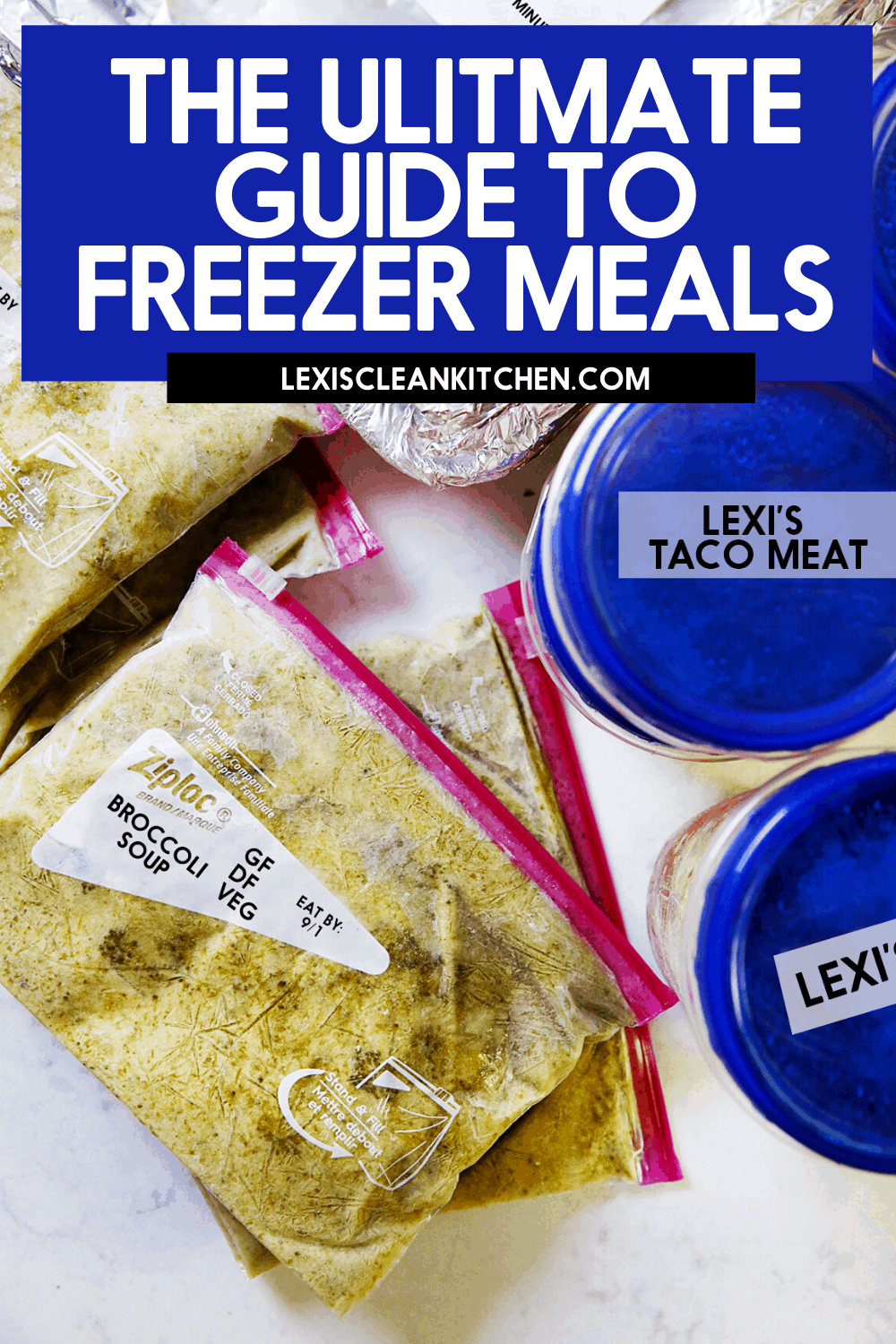
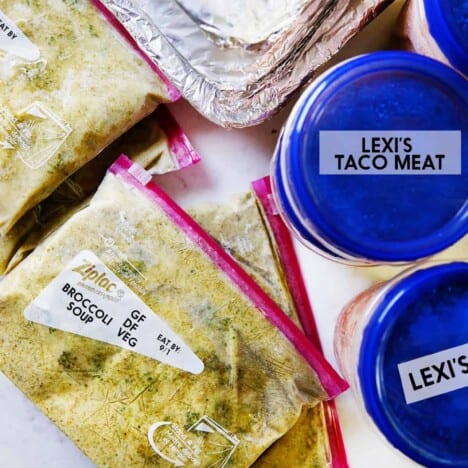
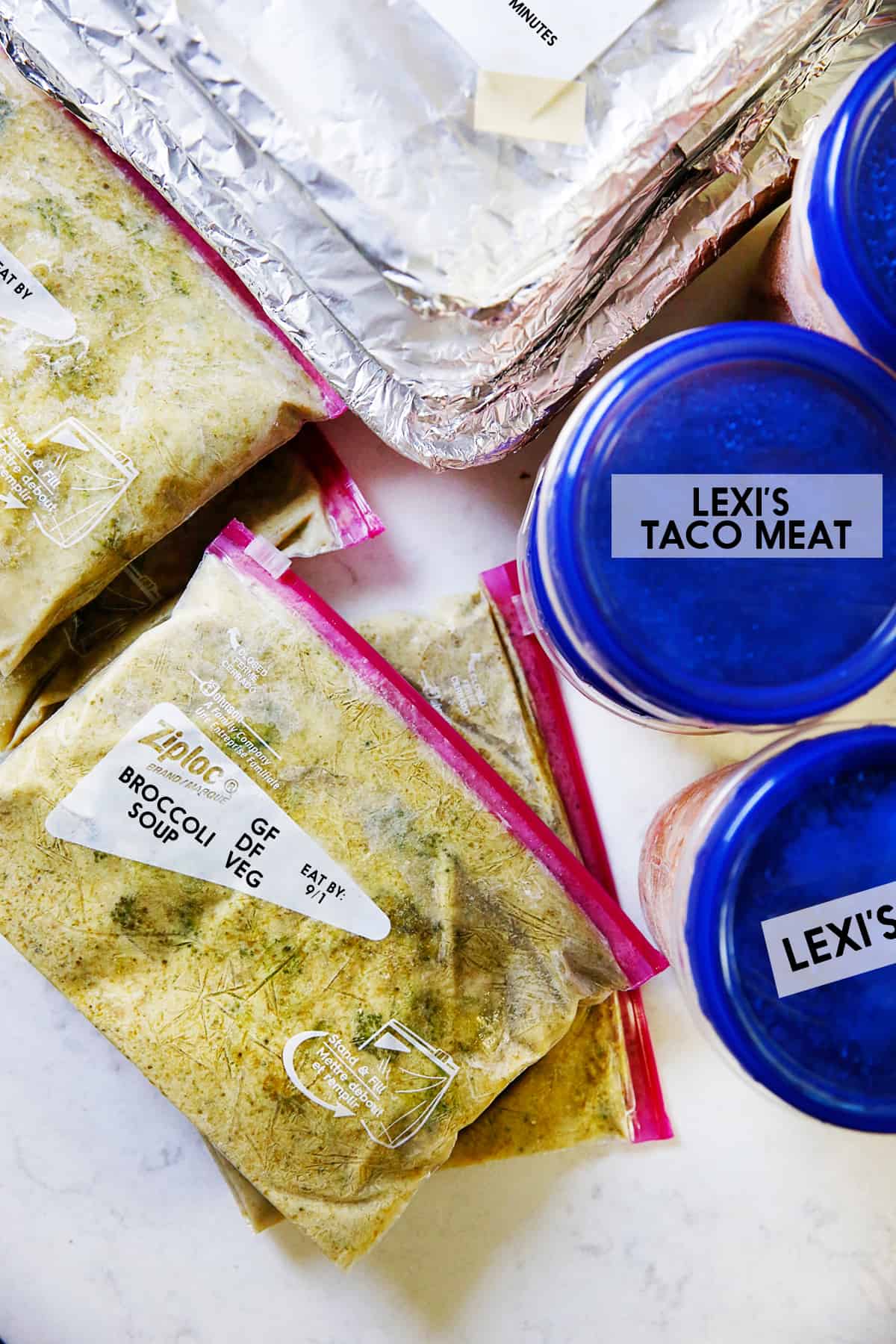 Freezer Cooking Food Safety
Freezer Cooking Food Safety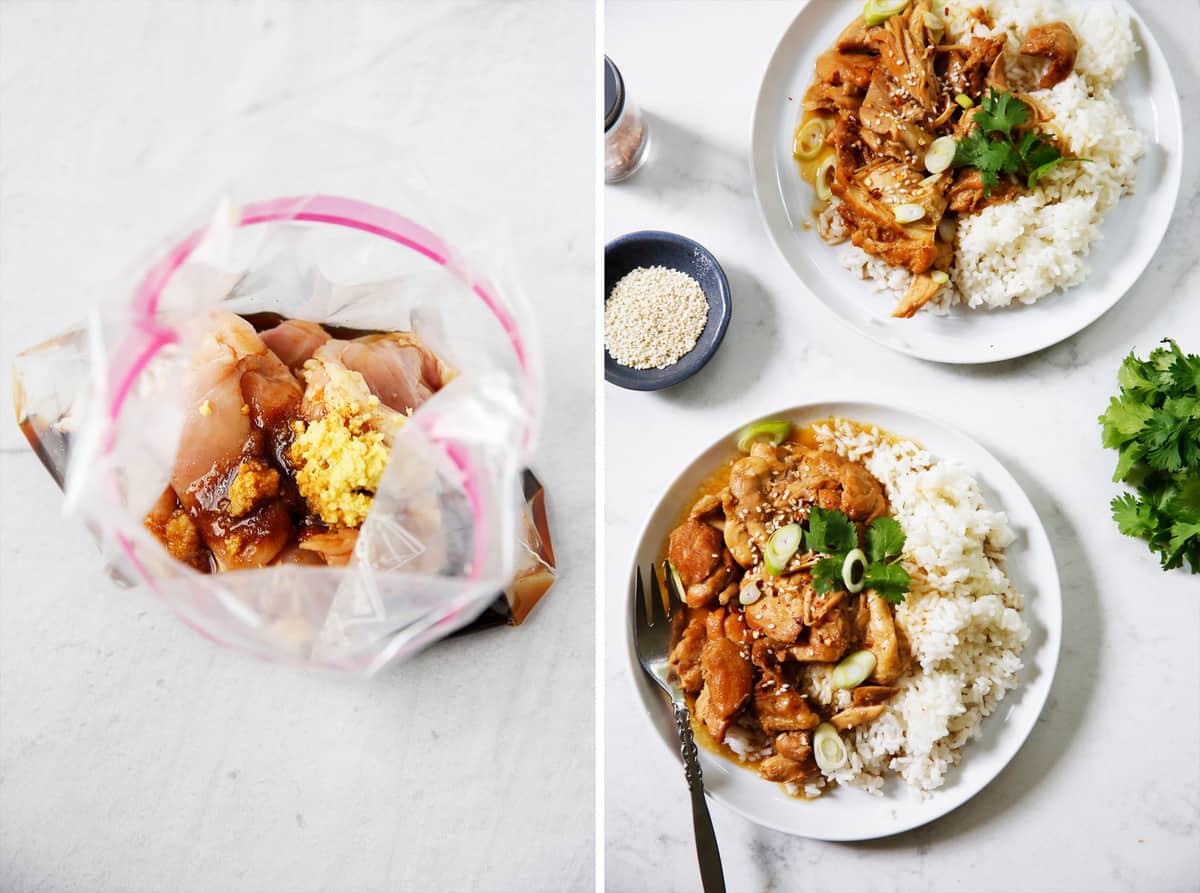 60 Healthy Freezer Meals and Ideas
60 Healthy Freezer Meals and Ideas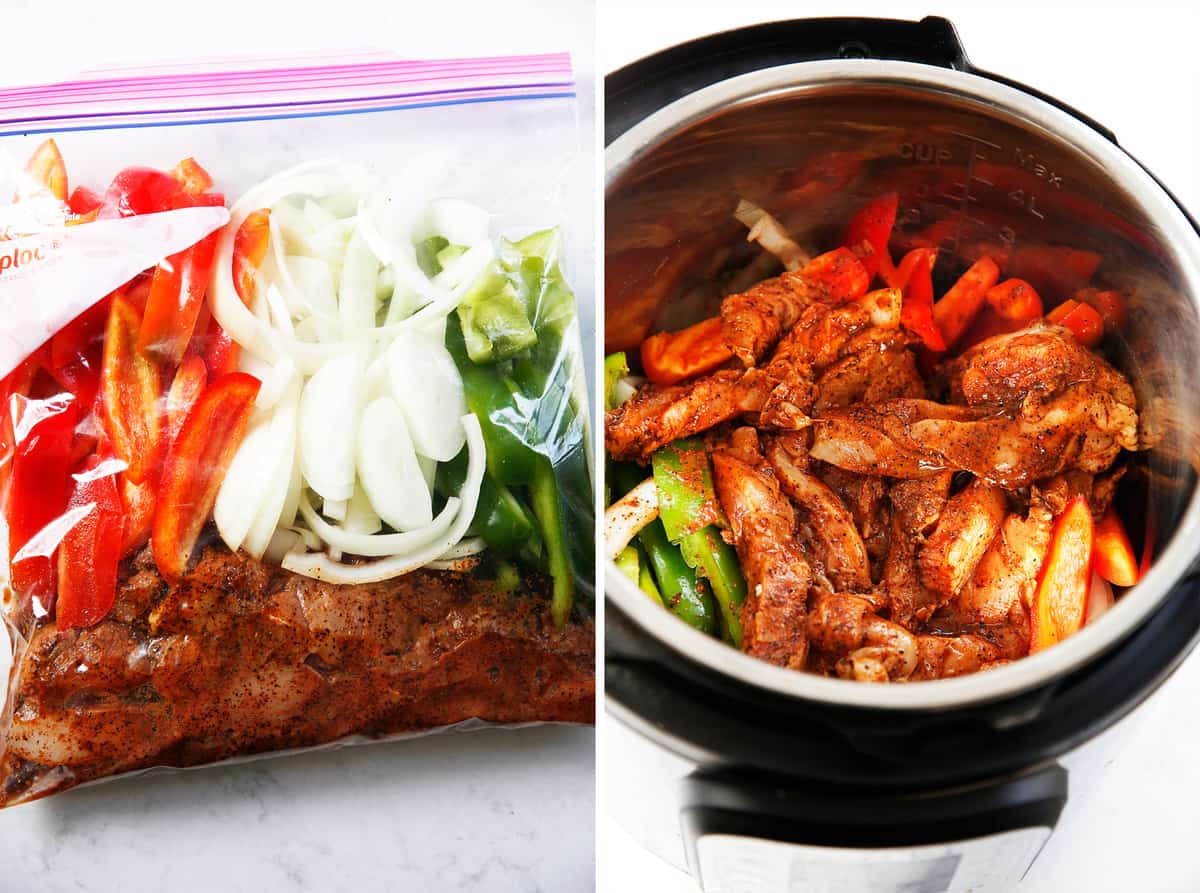
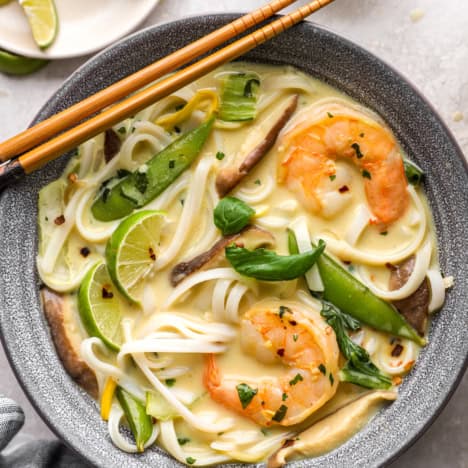

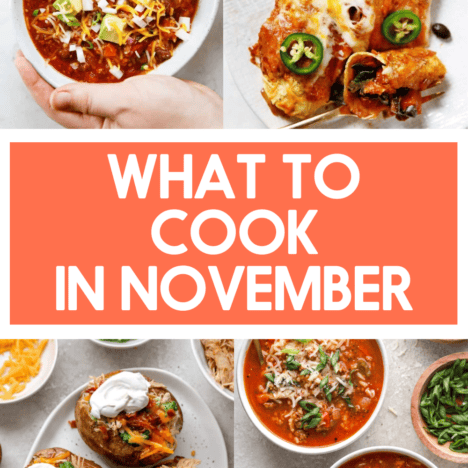
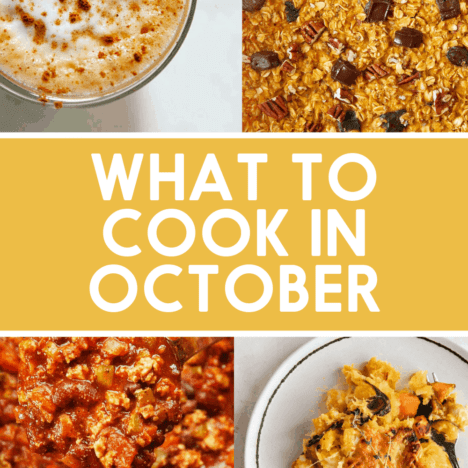


I love your information on freezing meals.
Thank you.
For the Carne Asada – do you do the full crockpot step or just searing the meat and then freeze with juice?
What do you use to label your bags or containers? Sharpie seems to disappear after a certain amount of time in the freezer.
Sharpie seems to do ok for me!
This guide is so helpful.
This guide is so helpful! I’m 33 weeks pregnant and used this guide both to freeze meals with ingredients I had on hand and I tried some of Lexi’s recipes too. The lasagna and potato leek frittata were two I made. My husband and I loved the lasagna (we doubled the recipe and ate one and froze the other) and can’t wait to try the frittata. This guide is so awesome!
We are so happy to hear it was helpful! That’s what we were hoping for 🙂
This is exactly what I needed! I love the colored labels–I have an allergy to wheat, dairy, egg, AND almond, so it’s been hard to find a good list of freezer meals like this one as I prep for baby to arrive…
I can’t wait to start making these! Thank you for putting these together. Just to confirm – unless stated otherwise – I can cook everything, then freeze it, then just reheat through without any need to thaw?
Thanks for sharing, ready for the holidays
This list. This list is AWESOME. It’s simple, doable, healthy, and everything looks amazing! Great ideas, tips, tricks, and inspiration! Thank you so much!
Can’t wait to try so many things on this list.
Thanks for this! What a great list.
🙂